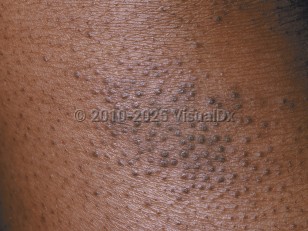In infants, the disease involves primarily the face, scalp, and torso. In children and adults, the disease usually involves chiefly the flexural aspects of extremities, but it may be more generalized. Follicular patterns of atopic dermatitis are more common in persons of color. A lichen planus-like appearance has also been reported in persons of color, due to lichenification and the difficulties in perceiving erythema in darker skin colors.
Atopic dermatitis may be categorized as follows:
- Acute – erythema, vesicles, bullae, weeping, crusting
- Subacute – scaly plaques, papules, round erosions, crusts
- Chronic eczema – lichenification, scaling, hyper- and hypopigmentation
Intense pruritus (itching) is a hallmark of atopic dermatitis. Scratching leads to lichenification (skin thickening from chronic trauma). Impaired barrier function leads to increased water loss and cutaneous infections. Patients with atopic dermatitis are prone to impetiginization with Staphylococcus aureus (impetigo). Secondary infections with herpes simplex virus (eczema herpeticum), Coxsackie viruses (eczema coxsackium), or vaccinia virus (eczema vaccinatum) may transpire.
Patients with atopic dermatitis have difficulties in retaining skin moisture and suffer from xerosis (dry skin). Environmental triggers, such as heat, humidity, detergents / soaps, abrasive clothing, chemicals, smoke, and even stress, tend to aggravate the condition. Latex allergy and nickel allergy occur more often in persons with atopic dermatitis. Additionally, patients with atopic dermatitis have been found to be more likely to have positive patch test results to products commonly found in topical treatments, including cocamidopropyl betaine, wool alcohol / lanolin, and tixocortol pivalate. Allergy to eggs, cow's milk, or peanuts is common. There may be a relationship between atopic dermatitis and the development of aspirin-related respiratory disease.
Atopic dermatitis can be differentiated from cellulitis on the basis of itching, scaling, and distribution. Atopic dermatitis is often observed bilaterally and in multiple body locations.



 Patient Information for
Patient Information for 
